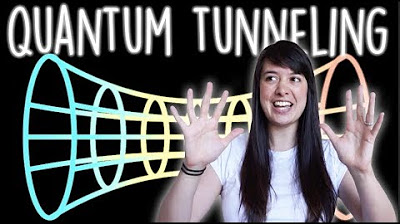Por Que Precisamos da Dualidade Onda-Partícula?
Summary
TLDRThis video explores the historical debate about the nature of light and matter, delving into how classical physics classified objects as particles or waves. The double-slit experiment showed light behaves as a wave, but phenomena like the photoelectric effect suggested it also behaves as a particle. Louis de Broglie extended this duality to matter, proposing that particles also exhibit wave-like behavior. These discoveries reshaped our understanding of quantum mechanics, challenging traditional views and demonstrating the evolving nature of scientific theories. The video concludes by reflecting on the potential for future breakthroughs that could further transform our worldview.
Takeaways
- 😀 Classical physics divides objects into two categories: particles and waves, with examples like water, chairs, and sound.
- 😀 Waves can be further divided into mechanical waves (e.g., sound) and electromagnetic waves (e.g., visible light).
- 😀 A wave does not carry matter, but it carries energy and information. This is in contrast to particles, which carry matter.
- 😀 The famous double-slit experiment, conducted by Thomas Young in 1801, demonstrated that light behaves as a wave.
- 😀 In the double-slit experiment, light passing through two slits creates an interference pattern, which is a characteristic of waves.
- 😀 At the end of the 19th century, it was confirmed that electricity is made up of particles, specifically electrons, by J.J. Thomson's cathode ray experiment.
- 😀 Despite a strong understanding of waves and particles, the photoelectric effect in the early 20th century challenged classical physics by showing that light also has particle-like properties.
- 😀 Max Planck's solution to the black-body radiation problem suggested that light behaves both as a wave and a particle, introducing wave-particle duality.
- 😀 Louis de Broglie extended the wave-particle duality concept to matter, suggesting that particles like electrons exhibit both wave and particle characteristics.
- 😀 Experiments confirmed that even electrons behave like waves, as demonstrated in a double-slit experiment with electrons, aligning with de Broglie’s theory.
Q & A
What are the two main categories that objects can be divided into according to classical physics?
-Objects are divided into two main categories: particles (e.g., water, chair) and waves (e.g., sound, light).
What is the key difference between waves and particles in classical physics?
-A particle is a piece of matter, while a wave does not carry matter but moves through material, carrying energy and information.
What was Thomas Young's experiment, and what did it demonstrate?
-Thomas Young's double-slit experiment in 1801 demonstrated that light behaves like a wave, as it showed an interference pattern when light passed through two slits.
How did J.J. Thomson contribute to the understanding of electricity in the late 19th century?
-J.J. Thomson confirmed that electricity is made up of particles smaller than atoms, specifically electrons, through his cathode ray tube experiment.
What was the issue with classical physics in explaining the photoelectric effect?
-Classical physics could not explain why certain colors of light could eject electrons from metal plates while others could not. This led to the proposal that light behaves as particles (photons).
How did Max Planck and Albert Einstein's work solve the problem with the photoelectric effect?
-They proposed that light is quantized, meaning it exists as particles (photons) with energy levels defined by Planck’s constant, resolving the issues with the photoelectric effect.
What is wave-particle duality, and who first proposed it for matter?
-Wave-particle duality is the concept that entities such as light and matter can exhibit both wave-like and particle-like behaviors. Louis de Broglie first proposed that matter, such as electrons, also behaves like a wave.
What experimental evidence supports the wave-particle duality of matter?
-Experiments with electrons, such as the double-slit experiment, showed that electrons behave like waves under certain conditions, providing evidence for wave-particle duality.
Why is it difficult to observe the wave properties of larger objects like humans or animals?
-The wavelength of larger objects, according to de Broglie’s equation, is extremely small, making it practically impossible to observe their wave properties in everyday life.
What philosophical implications does wave-particle duality have on our understanding of reality?
-Wave-particle duality challenges classical views of reality, suggesting that the nature of matter is not as deterministic as previously thought and may require a new understanding of the universe.
Outlines

Cette section est réservée aux utilisateurs payants. Améliorez votre compte pour accéder à cette section.
Améliorer maintenantMindmap

Cette section est réservée aux utilisateurs payants. Améliorez votre compte pour accéder à cette section.
Améliorer maintenantKeywords

Cette section est réservée aux utilisateurs payants. Améliorez votre compte pour accéder à cette section.
Améliorer maintenantHighlights

Cette section est réservée aux utilisateurs payants. Améliorez votre compte pour accéder à cette section.
Améliorer maintenantTranscripts

Cette section est réservée aux utilisateurs payants. Améliorez votre compte pour accéder à cette section.
Améliorer maintenantVoir Plus de Vidéos Connexes

Davisson-Germer Experiment & Wave-Particle Duality

What is Quantum Tunneling, Exactly?

The Quantum Theory of the Atom | Chapter 7 - General, Organic, and Biological Chemistry

Physical World Class 11 Physics - Scope of Physics

Quantum Mechanics: Animation explaining quantum physics

Classical physics vs Modern Physics
5.0 / 5 (0 votes)
